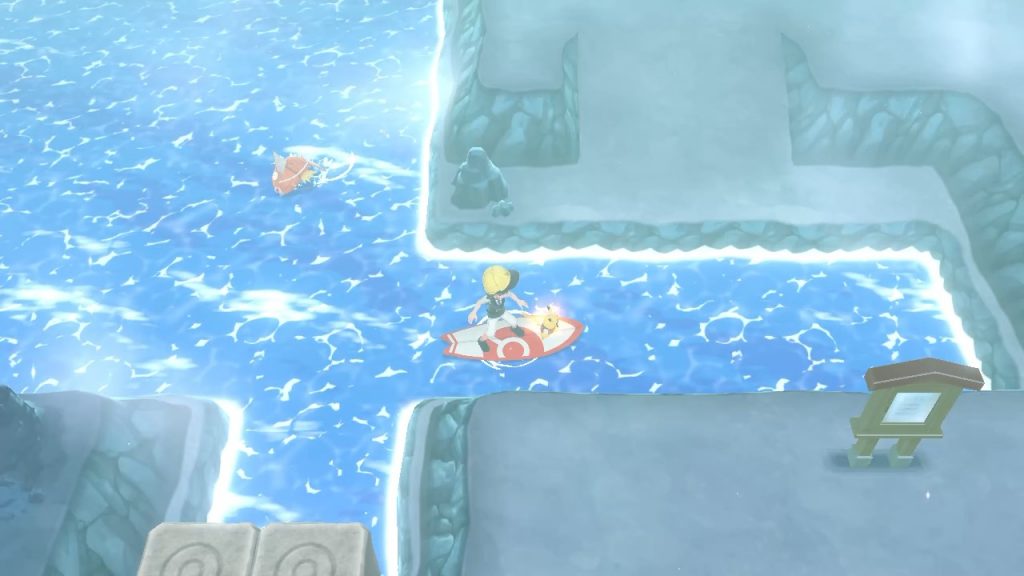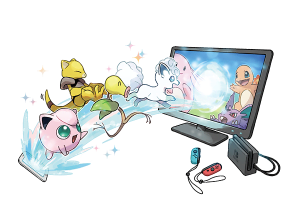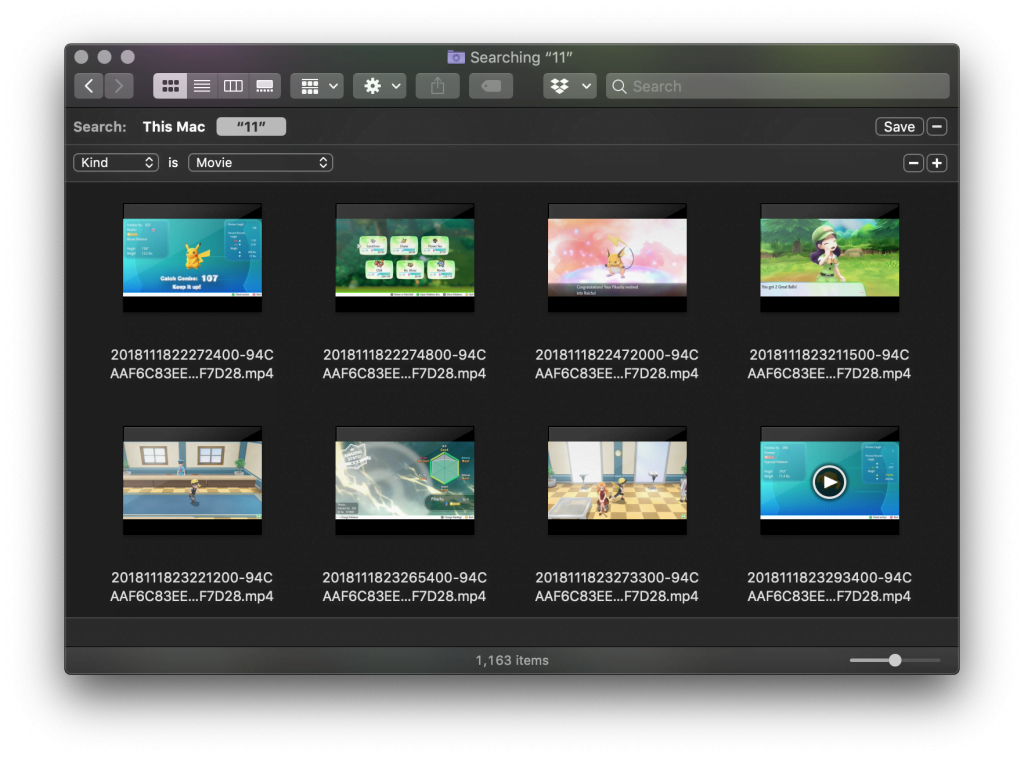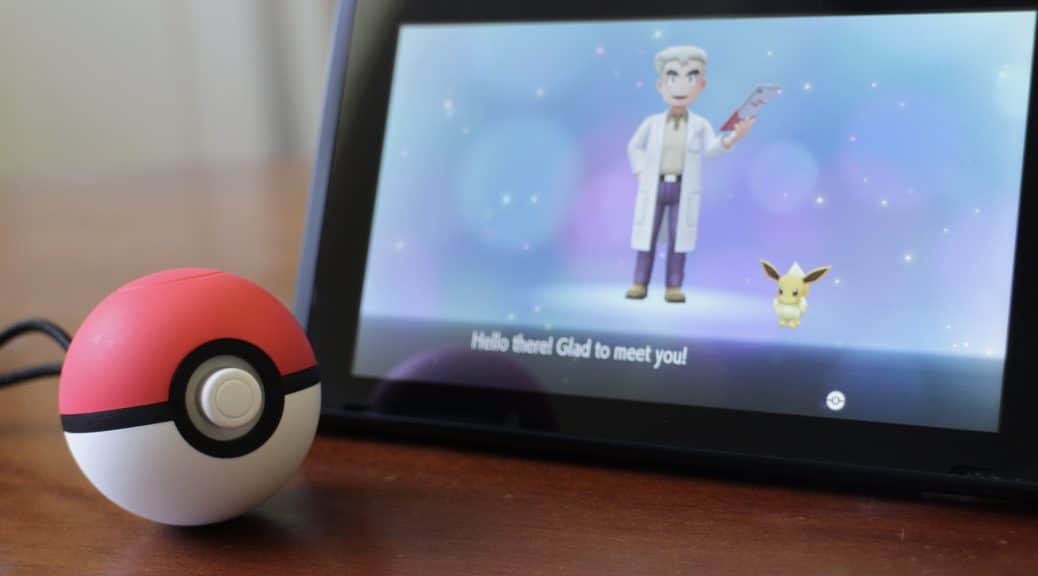Good, Fun Simplicity — Let’s Go Pikachu/Eevee and Poké Ball Plus Review
New Pokémon games are a great, yet different experience for all but the advanced battler. Both the games and the Poké Ball Plus are great complements to GO, too. Check out our extensive review on what’s different in Let’s Go, Pikachu! and Let’s Go, Eevee!
Catch Combos and Madame Celadon help you find the best
Two mechanics make it really easy to get the Pokémon you’d like — the first being Catch Combos, which help you get Pokémon with up four perfect IVs, and the second being a non-player character named Madame Celadon, who “predicts” the Natures of Pokémon you encounter.
These mechanics help, especially since Pokémon breeding is notably absent from the Let’s Go games. Breeding, as used in previous games, when set up properly with a Destiny Knot, allowed Pokémon being bred to pass on up to four guaranteed IVs, so most players would typically try to set up chains to end up pass on these stats and swap the Pokémon being bred to eventually attain a near-perfect Pokémon, with maximum IVs for all their stats. Advanced Trainers would also ensure that the ideal Nature was passed from the parents using an Everstone. For new players, this process might be cumbersome to work with.

The solution the Let’s Go games have in mind is far less of a chore, and in the case of Catch Combos, can be done immediately after you’ve left Pallet Town. Simply catch more and more of the same Pokémon in a row and as you build the combo. As you catch more of the same, you’ll be rewarded with those captures having guaranteed perfect stats — after the first 31, your captures will have a guaranteed four perfect IVs. What’s more, the chance of a Shiny Pokémon popping up also increases significantly as you build a combo. We have a guide for those interested in learning more.
The game even makes judging a Pokémon’s potential available as soon as Vermilion City — you’ll find Professor Oak’s assistant available to teach you the feature at the gate between Route 11 and Route 12. Once you’ve enabled the feature, it’s conveniently accessible via the Pokémon’s summary menu. Judging gives you an at-a-glance view of your Pokémon’s IVs and how high they are. Unlike Pokémon Sun and Pokémon Moon, the only requirement to unlock it is having 30 unique species recorded in your Pokédex, so it’s not some untold quest of hatching eggs like it was in those games.
For those who want their Pokémon to be of a particular Nature and won’t leave them to chance, upon reaching Celadon City, players will have access to Madame Celadon. This Channeler and her Abra are capable of making a prediction of the Nature of every Pokémon you come across for up to 24 hours, or once the game software is closed. You end up choosing what stat you’d like to buff and which stat you’d like decreased in exchange.
For when you become the Champion, and you‘ve found Bottle Caps, Hyper Training is back once more to round out the stats of your Pokémon (still for Level 100 Pokémon only, sadly). Mr. Hyper shows up at the Day-Care south of Cerulean City, and for the cost of one Bottle Cap, you can round out the IV of one of your Pokémon’s stats to the max. For maxing out all of the Pokémon’s stat IVs, Gold Bottle Caps are here, too, and can be found hidden in random spots at the Celadon City Game Corner.
To have all these functions available to you in the Let’s Go games is absolutely critical if you‘re serious about battling with these games. Given that “Normal Rules” remove Awakening Values, and those rules may be encouraged for standard play, you’ll be largely relying on the IVs your Pokémon have, their Nature, and the moves (since, again, Abilities and Hold Items aren’t here). They’re crazily convenient, accessible and would be useful to any Trainer who wants to dabble or deep-dive right into the battle scene, so let’s hope that they’ll be back in the eighth-generation games in some capacity.
Farewell Hidden Machines, hello Secret Techniques
The very first generation of Pokémon games gave us what fans would call a really outdated mechanic now — Hidden Machines (HMs). These were special TM moves that could be used in the field to clear certain obstacles that often impeded your story progress, and to enforce this, required a Badge. The moves taught by HMs were required to get from place to place in the games, and some of the moves weren’t very useful to some. What’s worse, these moves couldn’t be deleted, so they’d occupy a move slot that could’ve been assigned to a more useful attack. To alleviate the issue, Pokémon Sun and Moon replaced the mechanic with Poké Rides — Pokémon freely available to eligible Trainers who would be able to perform useful tasks such as shoving boulders and flying around the region. Poké Rides were activated as the story necessitated.
 Let’s Go, Pikachu! and Let’s Go, Eevee! gives similar types of abilities to your partner Pikachu or Eevee, in the form of Secret Techniques. These moves can’t be used in battle, so they have the bonus of not occupying a move slot. These techniques have the exact purposes in the overworld as the HMs found in the original games would teach, and are generally taught around the same points. HM01 Cut, for example, has been replaced with the Secret Technique Chop Down, and is taught by the captain of the S.S. Anne, much like in the first-generation games.
Let’s Go, Pikachu! and Let’s Go, Eevee! gives similar types of abilities to your partner Pikachu or Eevee, in the form of Secret Techniques. These moves can’t be used in battle, so they have the bonus of not occupying a move slot. These techniques have the exact purposes in the overworld as the HMs found in the original games would teach, and are generally taught around the same points. HM01 Cut, for example, has been replaced with the Secret Technique Chop Down, and is taught by the captain of the S.S. Anne, much like in the first-generation games.
Hopefully, the eighth-generation games find as good an excuse to keep HMs dead once again.
GO Park is a nice integration with Pokémon GO
 Pokémon GO support is another of the headlining features for the Let’s Go games. The ability to connect to the games and transfer Pokémon across is available a little late into the game — you’ll be traveling all the way to Fuchsia City, first.
Pokémon GO support is another of the headlining features for the Let’s Go games. The ability to connect to the games and transfer Pokémon across is available a little late into the game — you’ll be traveling all the way to Fuchsia City, first.
Once there, though, connecting Pokémon GO to Let’s Go, Pikachu! and Let’s Go, Eevee! is a seamless, painless experience. You simply select a Park to send Pokémon to, select Pokémon via GO, and transfer them in. Take note that the transfer is one way only — Pokémon sent to Let’s Go cannot be sent back into Pokémon GO.
Once sent into a Park, the player can go in and interact with the Pokémon transferred in, or capture them. Pokémon that are transferred have their stats recalculated to fit the mechanics of Let’s Go — while the Speed stat of a Pokémon is calculated randomly, the Stamina, Attack and Defense IVs from GO are converted to HP, both Attack stats, and both Defense stats respectively. Since IVs in Pokémon GO have a maximum of 15 points where traditional games and the Let’s Go games cap the stats at 31, transferred Pokémon have their stats doubled and then have one point added on top. If you’ve got a near-perfect Pokémon travelling between GO to Let’s Go, its perfect stat will port across fine.
Transfer up to 25 of certain Pokémon and you’ll be able to access the Play Yard, where you can participate in a special mini-game. The Play Yard mini-game is simple: gather the Pokémon around the Park while avoiding obstacles that will cause your gathered Pokémon to scatter. It’s a really nice little integration, but it does require you to have a good handful of a particular Pokémon to transfer in the first place.
The same sounds of Kanto, but better
Shota Kageyama, composer for Pokémon since HeartGold and SoulSilver and sound team director for Black and White all the way to Omega Ruby and Alpha Sapphire, quit Game Freak to become a freelance composer in 2014. If you were a fan of the music in the games he’s composed for, good news: he’s back, if only for a guest stint, working on music for a Pokémon game once more. With Let’s Go, Pikachu! and Let’s Go, Eevee!, Kageyama has been tasked with rearranging the Pokémon Red and Blue soundtrack originally composed by Junichi Masuda.
The rearranged soundtrack is a wonderful rendition of the original 8-bit soundtrack from the first-generation games. Just about every track from the original games are here, plus a couple of brand-new compositions. The orchestra-style rearrangements sound amazing, and are complemented by a violin and electric guitar for some themes for emphasis. For the Nintendo Switch’s first Pokémon entry, the tracks make for a great impression on the platform. Turn on the speakers or hook up the headphones, because the games sound great.
If there’s a criticism to be made, it’s the scarce amount of new tracks. It feels like a missed opportunity to not have new themes in the game to make the games feel more modern — perhaps a distinctive Elite Four battle theme rather than the Gym Leader theme or a rearranged Poké Mart theme would be nice. Team Rocket aren’t given special treatment either — their battles reuse the same regular “VS Trainer” theme as every other Trainer in the game. It’s a nitpick against a great soundtrack, but composing new tracks for important characters seems like one of those things that makes the game feel more complete. It’s a shame that the Let’s Go games only feel like they’re nearly there.
And a few other small things
Let’s Go, Pikachu! and Let’s Go, Eevee! do feature some things that help makes things easier for all players.
Pokémon are no longer sent to a Storage System that has to be accessed via a PC — they are now instead stored in the Pokémon Box in your Bag. To be able to change over your party outside of battle is a boon, especially since it takes out the need to travel to a Pokémon Center to use the PC there.
While the Let’s Go games aren’t chock full of cutscenes to the extent that the seventh-generation Pokémon games are, a “Movie Skipping” option has been added to the Options menu, allowing you to enable skipping cutscenes by pressing the – or + buttons. You’ll find this useful if you just want to get on with the game and don’t care for story progression.
Like Pokémon Omega Ruby and Alpha Sapphire, the ability to fast-travel to other locations is available via the Town Map once the Sky Dash Secret Technique is unlocked. You can only fly to other cities and towns, however: these games don’t grant you the ability to fly directly to other routes.
We’ve already mentioned that Exp. Points are awarded for each successful Pokémon capture. They’re also awarded by defeating other Trainers’ Pokémon, and are also distributed to the entire party, this time without the use of an Exp. Share. You aren’t given the option of turning Exp. distribution off, but the the Let’s Go games seem to compensate for this and the lack of wild battles with lower average levels for Trainers’ Pokémon in the early part of the game. The games also raise the average levels for Trainers’ Pokémon in the latter half of the game, so you’re not as likely to end up extremely overlevelled without grinding for it.
The Let’s Go games are the first in a long time to not feature a shortcut button — the Y button goes unused in the field for these games. The game has several instances where this would actually be useful — perhaps switching straight to the Pokémon Box in your bag, opening the Town Map to fly around, or dismounting your flying ride Pokémon in the post-game. These are some particularly otherwise clunky features that could benefit from a shortcut button to toggle them, particularly since there’s no Bicycle in the game which you would assign to that button.
Screen and Video Capture support, finally
Most games on the Nintendo 3DS allowed users to save screenshots of their gameplay into their Miiverse albums, or post them directly to Miiverse with a comment. It was a roundabout way to actually get screenshots from your game, but for most users it was — at least until Miiverse’s closure — the only way to get screenshots from their games. With all the Pokémon role-playing games made for the Nintendo 3DS, however, this feature was inexplicably disabled.
Given the tendency to disable any screen capture features, it may be a surprise that the Let’s Go games support screen capture and video capture on the Switch! You can even share the screenshots and videos straight from the Switch, or transfer them to a microSD card and post them to YouTube — perfect for sharing that moment you caught a shiny, or even battled the Metapod Master Trainer.

